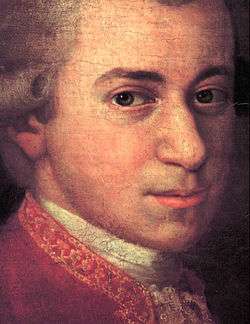Bassoon Concerto (Mozart)
The Bassoon Concerto in B flat major, K. 191/186e, written in 1774 by Wolfgang Amadeus Mozart, is the most often performed and studied piece in the entire bassoon repertory.[1] Nearly all professional bassoonists will perform the piece at some stage in their career, and it is probably the most commonly requested piece in orchestral auditions – it is usually requested that the player perform excerpts from the concerto's first two movements in every audition.
Although the autograph score is lost, the exact date of its completion is known: 4 June 1774.[2]
Mozart wrote the bassoon concerto when he was 18 years old, and it was his first concerto for a wind instrument.[3] Although it is believed that it was commissioned by an aristocratic amateur bassoon player Thaddäus Freiherr von Dürnitz, who owned seventy-four works by Mozart, this is a claim that is supported by little evidence.[4] Scholars believe that Mozart may have written five[5] bassoon concerti, but that only the first has survived.
Instrumentation
The concerto is scored for a solo bassoon and an orchestra consisting of 2 oboes, 2 horns in Bb (sometimes transcribed for F), violin I/II, viola, and cello and double bass doubling the bass line.
Structure
The piece itself is divided into three movements:
The first movement is written in the common sonata form with an orchestral introduction. The second movement is a slow and lyrical sonata without development that contains a theme which was later featured in the Countess's aria "Porgi, Amor" at the beginning of the second act of Mozart's opera Le nozze di Figaro. The final movement is in rondo form.
Media
 |
Allegro
1st movement. Performed by Arthur Grossman, bassoon, with the 7th Army Symphony Orchestra (1957) Bassoon Concerto in B flat Major, I. Allegro
Performed by the Skidmore College Orchestra. Courtesy of Musopen Andante ma adagio.
2nd movement. Performed by Arthur Grossman with the 7th Army Symphony Orchestra (1957) Rondo Tempo di Menuetto
3rd movement. Performed by Arthur Grossman with the 7th Army Symphony Orchestra (1957) |
| Problems playing these files? See media help. | |
See also
Notes
- ↑ Eisen, Cliff: 'Concerto', Grove Music Online ed. L. Macy (Accessed 6 August 2006), <http://www.grovemusic.com.turing.library.northwestern.edu>
- ↑ Sleeve note of the Supraphon CD (SU 3678-2 001)
- ↑ Mozart, W. A.; Giegling, Franz (foreword) (2003). Konzert in B für Fagott und Orchester. Kassel: Bärenreiter-Verlag. p. VII. ISMN M-006-45809-7
- ↑ Waterhouse, William: 'Bassoon', Grove Music Online ed. L. Macy (Accessed 6 August 2006), <http://www.grovemusic.com.turing.library.northwestern.edu>
- ↑ Huscher, Phillip (5 June 2014). "Mozart's Bassoon Concerto, 'a little masterpiece'". Chicago Symphony Orchestra. Retrieved 7 December 2015.
External links
- Konzert in B für Fagott und Orchester KV 191 (186e): Score and critical report (German) in the Neue Mozart-Ausgabe
- Bassoon Concerto: Scores at the International Music Score Library Project
